Yosemite: Change Revisited
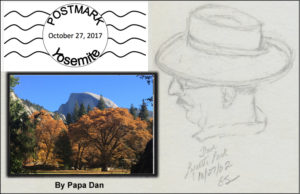
“It is easier to feel than to realize,
or in any way explain, Yosemite’s grandeur.”
— John Muir
“What a treasure to pass on . . .
(but make sure you bring your lunch).”
— PapaDan
Click here to download a PDF of this post:Yosemite, October 17, 2017
= = = = = = = = = = = = = = = = = = = = = = = = = = = = = = = = = = = = = = = =
Yosemite, October 17, 2017
 Sitting here in the middle of a meadow, looking up at Yosemite’s venerable Ahwahnee Hotel, it seems different in some way. Since you probably know some of the history of this place, you may ask with raised eyebrow and derision in your voice “Aw-come-on-now, what could possibly be different?” You might point out a few things like: the iconic stone-and-wood edifice in front of me has looked pretty much the same since it opened in 1927; the granite mountain, El Capitan, to the left of this view has looked much the same for, oh, 50,000 years or so; and the squirrels and blue jays who live here have been scurrying and squawking like this since the glacier melted — so, what could possibly be different?
Sitting here in the middle of a meadow, looking up at Yosemite’s venerable Ahwahnee Hotel, it seems different in some way. Since you probably know some of the history of this place, you may ask with raised eyebrow and derision in your voice “Aw-come-on-now, what could possibly be different?” You might point out a few things like: the iconic stone-and-wood edifice in front of me has looked pretty much the same since it opened in 1927; the granite mountain, El Capitan, to the left of this view has looked much the same for, oh, 50,000 years or so; and the squirrels and blue jays who live here have been scurrying and squawking like this since the glacier melted — so, what could possibly be different?
I’ll have think about it — you’ve asked a big question that demands a big answer; but I, of course, have a small answer:
—> It’s quiet. Nearly silent, actually. THAT’S what’s different.
Gretta and I come to Yosemite every April, for our anniversary, and one thing is a constant — Yosemite Falls is always flowing with its usual vigor. The sound is not merely of running water, but of chunks of ice and fragments of logs from the high country crashing down on the rock formations between the peak of the falls and the valley floor. All of that — plus the constant rushing of the water — creates a polyphonic orchestration complete with percussion, and you can hear it everywhere in Yosemite Valley from Half Dome to El Capitan to Glacier Point.
But, in October (for our second yearly visit), North America’s tallest waterfall is completely dry.
And silent. And, the silence of October is more noticeable than the sound of April. 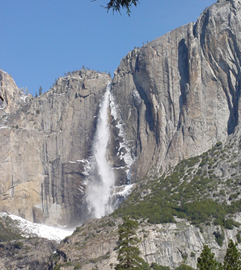
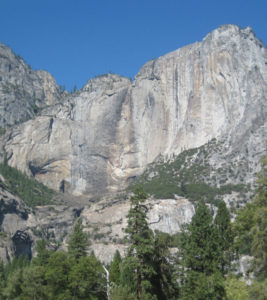
Upper Yosemite Falls (April) Upper Yosemite Falls (October/Dry/Silent)
But, before I claim that everything else around here is permanent, I come to realize that much has changed, and is changing all the time. Some of it matters, and some doesn’t.
The Water
• The water that feeds the Merced River from the opposite side of Yosemite Valley, across from Yosemite Falls (see the images below), originates at the granite dome of Liberty Cap, thunders down at Nevada Falls, sits awhile in the Emerald Pool, rumbles down at Vernal Falls, and ends up meandering through the valley floor in the Merced River. As the seasons change, that river trickles between the boulders at its low point here on October and then swells to a wide, white-water torrent in April. So, at least that much changes; but a wise observer might point out that all of this ebb and flow, the meandering and the raging, the silence and the music of the falls form a never-ending constant cycle in their seemingly eternal alternation between the extremes of life in this valley among these mountains. Yosemite has been here a very long time — longer than the life-span of humans on this planet — and the forces at work here seem to be eternal; BUT those forces are carving a work of art. Each time you look, if you are paying attention, it never looks quite the same as it did the last time you looked.
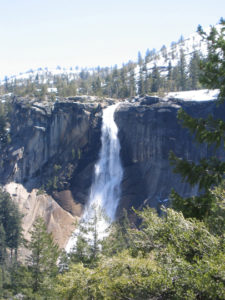

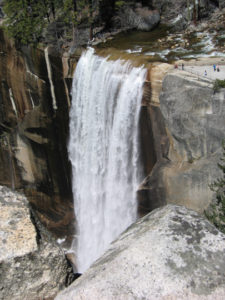
Nevada Falls Top of Vernal Falls/Emerald Pool Vernal Falls
The Granite
• Today, El Capitan slopes at a slightly different angle since last month when a slice of granite the size of an apartment building cracked and crashed down on one of its outcroppings and scattered giant boulders, many the size of automobiles, around its base. Rock falls happen all the time in Yosemite but they are seldom fatal (as this one was) and often not especially noticeable — unless you consider that this entire valley and its surrounding mountains were carved and shaped over thousands of years in precisely this manner. So, Yosemite changes its shape pretty much everywhere you look and pretty much all the time.
The Colors
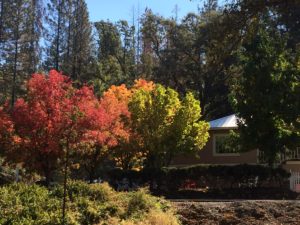
The colors speak for themselves. BUT, some of us have tried to speak for them — and maybe overdone it in the attempt, or not – like our old friend Mark Twain who tries to give us a glimpse, in words, of trees in the fall that change “from green to red, from red to green, and green to gold. The tree becomes a very explosion of dazzling jewels; it stands there, the acme, the climax, the supremest possibility of art or nature, of bewildering, intoxicating, intolerable magnificence. One cannot make the words too strong.” Or so he said.
Twain’s words appeared in the New York Times in 1876, not as evidence of change, but as evidence of permanence — describing something that has been repeated every year since long before humans were here to observe it. And here, now, in Yosemite, we see it once again.
Trivial Change
Now, if we’re going to make a list, some things HAVE changed here in Yosemite, just in the decades we have known it; but those are caused by humans and, therefore, less important:
• The Ahwahnee Hotel has been renamed The Majestic Yosemite Hotel. Why? — because the previous management of the hotel claims to “own” the name “Ahwahnee” after a coupla decades of association with it. The silliness of that view comes to light when you consider that the hotel was named for the Ahwahneechi Tribe who were associated with this part of the valley since about 600 years ago — long before the United States National Park Service granted a contract for restaurants and hotels (OK, long before the United States existed). So, Gretta and I still call it by its rightful name — The Ahwahnee Hotel.
• The Ahwahnee cocktail lounge, which used to serve excellent food all day long, now serves, well … OS (i.e., other stuff). We tried it for breakfast this time … I didn’t know it was possible to screw up yogurt and granola, but now I know. It has been our habit to enjoy a cocktail and tasty appetizers here in the late afternoon. The “cocktail” part endures as it should but the “tasty appetizer” notion is missing. It also used to feature a delightful piano player in the evening (he played everything from classics to smooth jazz to show tunes to classic rock — request almost anything, he knew it). Now the piano is gone to make room for three more tables and a sound system plays, well … OS.
• The Ahwahnee main dining room used to be a 5-star restaurant that attracted outstanding chefs. Now it is just a lovely high-ceilinged, grand building with an OK restaurant surrounded by breath-taking views, pouring from a mediocre wine list, and serving … well, you know, OS. It isn’t even the best restaurant in this valley.
• Oh, and there’s Degnan’s Deli, which used to be an ideal spot to interrupt a day of hiking by ordering a hand-made sandwich, salad, or soup, crafted with fresh ingredients. Now, it is dominated by a display case full of pre-packaged “gas-station-sandwiches.” And they’ve innovated: you can stand in line to order and pay using computerized kiosks and then stand in another line to pick up your order. This “innovation” succeeded in eliminating four employees who used to make your lunch to order from fresh ingredients and take your money at enough cash registers to avoid standing in line. You can still sit at their outdoor stone tables looking up at a stunning view of Glacier Point, but … my recommendation is that you bring your own lunch. Yes, it’s changed.
So, now I’ll stop whining
and tell you why we must continue to return here twice a year.
We come back for the many wonderful things that remain the same here in Yosemite Valley. Here are a few of those in the words of some of our friends:
• Words from Teddy Roosevelt: “There can be nothing in the world more beautiful than the Yosemite … and our people should see to it that [it] is preserved for their children and their children’s children forever, with [its] majestic beauty unmarred.”
• Words from John Muir: “Climb the mountains and get their good tidings, Nature’s peace will flow into you as sunshine flows into trees. The winds will blow their own freshness into you and the storms their energy, while cares will drop off like autumn leaves. As age comes on, one source of enjoyment after another is closed, but nature’s sources never fail.
• John Muir again: “It is easier to feel than to realize, or in any way explain, Yosemite’s grandeur. The magnitudes of the rocks and trees and streams are so delicately harmonized, mostly hidden.”
• Frightening words of warning from NYT columnist Nicholas Kristof: “I can’t help thinking that if the American West were discovered today, the most glorious bits would be sold off to the highest bidder. Yosemite might be nothing but weekend homes for internet tycoons.”
• Words from Robert Redford: “I spent two summers working at Camp Curry and at Yosemite Lodge as a waiter. It gave me a chance to really be there every day – to hike up to Vernal Falls or Nevada Falls. It just took me really deep into it. Yosemite claimed me.”
• Words from Dave Brubeck: “I used to take my mother to Yosemite. When got my driver’s license, that’s where she’d want to go, so I’d go take her there for two weeks.”
• Words from John Garamendi: “Maybe you weren’t born with a silver spoon in your mouth, but like every American, you carry a deed to 635 million acres of public lands. That’s right. Even if you don’t own a house or the latest computer on the market, you own Yosemite, Yellowstone, the Grand Canyon, Golden Gate National Recreation Area, and many other natural treasures.”
• Words from Ansel Adams: “Yosemite Valley, to me, is always a sunrise, a glitter of green and golden wonder in a vast edifice of stone and space.”
• More from John Muir: “During my first years in the Sierra, I was ever calling on everybody within reach to admire them, but I found no one half warm enough until Emerson came. I had read his essays, and felt sure that of all men he would best interpret the sayings of these noble mountains and trees. Nor was my faith weakened when I met him in Yosemite.”
• And, finally, from PapaDan: “Some years, one or more of our sons bring their families up here during the same week we visit, and we have the privilege of taking our grandchildren to the bank of the Merced River (below, left) or up to the base of Yosemite falls (below, right) and watch them enjoy the spectacle in amazement. What a treasure to pass on to the next generation!”
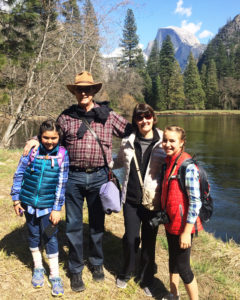

We’ll be back in April!
If you’re interested, click to take a look at a previous post on this topic:
“Of Permanence, Change, and a Sense of Wonder“
Beautiful descriptions of a beautiful area!
Thanks for the memory!
Love, Bunny
So pleased you enjoy your traditions so much and your family is following in your path. Rita and I, surprisingly, don’t have any traditions that take us to the same places year after year. Probably because our thing is to look for new places to add to our memories. We do have fond memories of numerous trips to Yosemite and most likely will return. There are so many other national parks we haven’t visited, so our travels will most likely be focused on them.. Plus, there is the rest of the world. So much to see.
Yes, we’ve tried to see “the rest of the world” and you and Rita have helped us do that (Varenna and Provence). But some places feel like “home” — like Yosemite (twice a year) and Varenna (six times since 2001). Yosemite is so easy to get to; so, we keep going back when we can. It could be that Ashland is starting to feel that way as well (twice now).